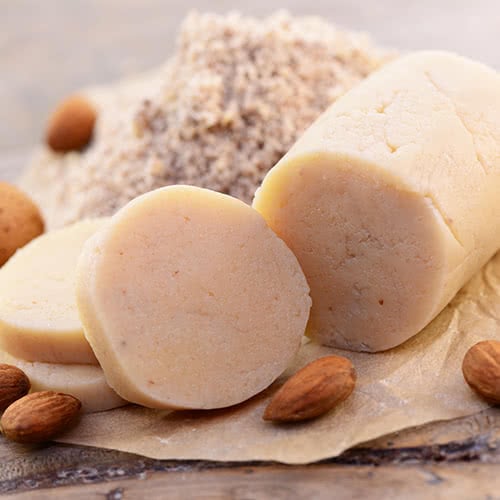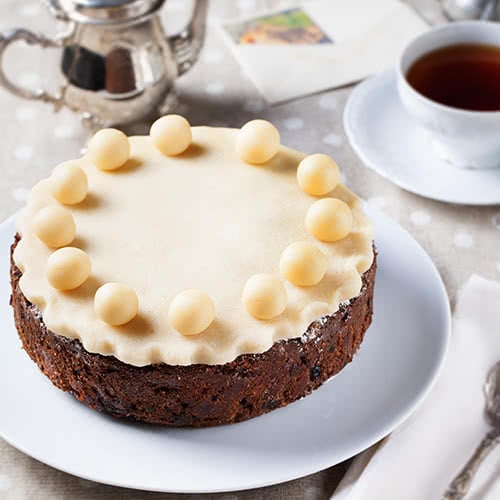Marzipan, Frangipane, Almond Paste, and Fondant: What’s the Difference?
Last updated on Feb 2, 2023Janine JonesIn the world of baking and confectionary work, you will find several ingredients that are very similar to each other but serve very different purposes. Marzipan is one of those ingredients that often gets mistaken with another due to its consistency and make up. With names so similar, what is the difference between marzipan and frangipane? What about marzipan and almond paste or marzipan and fondant? We set out to clarify these differences and find out how all of these ingredients are properly used.
Shop All Bakery Decorating IngredientsYou can use the list below to navigate through the different sections:
- What is Marzipan?
- What is Fondant?
- Marzipan vs Fondant
- What is Frangipane?
- Marzipan vs Frangipane
- What is Almond Paste?
- Marzipan vs Almond Paste
What is Marzipan?

Marzipan, also known as almond candy dough, is a smooth and pliable confectionary paste made from almonds that can be used as a cake icing or molded into candies. It features a clay-like consistency that makes it easy to handle. This popular confection is often used in British baking recipes, but variations of marzipan can be found in French and German baking as well. Marzipan can be located in most international supermarkets, sold in a tub or plastic-wrapped log.
How to Make Marzipan
There are several marzipan recipes available with slight variation, but the basic marzipan ingredients include almonds, sugar, and a binding agent. Persipan is similar to marzipan but is made out of apricot or peach kernels instead of almonds, and is often used as a substitute in the event of nut allergies.
Here are some common marzipan recipe options:
- Ground skinless almonds, powdered sugar, egg whites, and almond extract
- Almond paste, powdered sugar, and corn syrup
- Almond paste, sugar, water, and unbeaten egg whites
- Ground almonds, sugar, glucose syrup, water, and egg whites (optional)
- Blanched ground almonds, sugar, and starch or sorbitol
This is just one recipe for homemade marzipan that you can follow:
- Cover 1/2 pound of almonds with boiling water
- Let it sit until cool
- Pinch each almond to slide the skin off
- Drain the skinless almonds of any excess liquid
- Place the almonds in a food processor
- Add 2 cups (16 oz) of powdered sugar over the almonds
- Run the processor until the mixture is smooth
- Scrape down the sides and run the processor for another minute
- Add 2 egg whites into the mixture
- Blend until the mixture develops a clay-like consistency
- Add a 1/2 teaspoon of almond extract and a 1/2 teaspoon of salt, plus any additional spices to enhance the flavor
- Remove the mixture from the bowl and use immediately or wrap in cling wrap and store in the refrigerator (the mixture can be stored for up to 2 weeks)
The final result should produce a malleable speckled-white dough that is ready to use for all sorts of confectionary treats.
How to Use Marzipan

You can use marzipan in a variety of ways. It can be:
- Rolled out into a sheet and used as icing on cakes and cupcakes
- Added in cookie and biscuit recipes to make nutty marzipan cookies
- Sculpted into decoration such as fruits, animals, bows, etc. for cake decorations or marzipan candy
- Easily dyed and painted with edible paint because of the neutral marzipan color
- Used as the sweet center of chocolate covered marzipan candies
What Does Marzipan Taste Like?
Marzipan has a nutty flavor derived from the almonds in the mixture and can be very sweet.
What is Fondant?

Fondant is a smooth sugar paste that is popular in bakeries for cake decorating. There are a few different types of fondant as well. Rolled fondant is the more common type of fondant used in professional and amateur baking, however poured fondant can also be found in commercial settings. Fondant can often be found sold in pre-packaged tubs.
How to Make Fondant
The main ingredient used in a fondant recipe is confectioners sugar regardless of the variation of fondant you make.
- Rolled fondant is made by mixing powdered sugar, corn syrup, and shortening or vegetable oil until the mixture is firm and pliable. Gelatin is often added as well.
- Marshmallow fondant is made by melting mini marshmallows in the microwave with some water and then mixed with powdered sugar and vegetable shortening until the mixture is pliable.
- Poured fondant is made by boiling confectioners sugar, corn syrup, and water until it becomes opaque and creamy in consistency.
How to Use Fondant
Fondant is mostly used for baking decoration, however the two variations of fondant serve different purposes in the baking world.
Rolled fondant and marshmallow fondant tend to be pliable and dough-like in texture. It can be:

- Dyed to form a variety of colored fondant
- Rolled out into sheets and layed over cakes as a smooth icing layer
- Molded into decorations as sculpting fondant for cakes and cupcakes
- Softened to form gum paste or sugar paste that hardens over time
Poured fondant is creamy in consistency. It can be:
- Used as a filling for candies
- Drizzled over cakes and cookies for decoration
What Does Fondant Taste Like?
Fondant can be very sweet and sugary due to the high sugar levels, but provides a neutral taste for icing.
Marzipan vs Fondant
The similarities between marzipan and fondant are their texture and purpose. They are both malleable and can both be used interchangeably as a solid icing layer over cakes. They are easily dyed to create colorful and eye-catching decorations for cakes and cupcakes, and they are often used to make candies as well.
For their differences, marzipan tends to be more pliable than fondant and is less likely to crack when being handled, making it easier to work with. Marzipan features a nutty subtle flavor that complements certain recipes while fondant is a more neutral sweeter alternative. Although fondant has a tendency to dry out when handled, it makes for an excellent substitute if nut allergies are a concern.
What is Frangipane?

Frangipane is an almond pastry cream that is used as a filling in a variety of pastries and cakes. It has a light and spreadable consistency. Frangipane can often be found as an ingredient in French baking and is typically associated with Christmas celebrations in France. Frangipane is generally sold in a powder form, requiring additional ingredients for its preparation.
How to Make Frangipane
A frangipane recipe mainly consists of ground almonds, butter, flour, sugar, and eggs. You can follow the steps below to make your own homemade frangipane filling:
- Add 3 tablespoons of softened butter and 1/4 cups of granulated sugar to a mixing bowl
- Cream the mixture together until soft
- Add the 1/2 cup ground skinless almonds to the mixture and blend
- Add 1 egg and 3/4 of a teaspoon of vanilla extract to the bowl and continue to mix until incorporated
- Add 1 tablespoon of all-purpose flour and blend into the mixture
- Place the mixture into a piping bag to begin filling your pastries
The final result should produce a light tan cream that is enough for one large frangipane tart or several pastries.
How to Use Frangipane

Frangipane is used almost exclusively as a custard-like filling for pastries. Here are some pastries that incorporate frangipane into their recipes:
- Filled Croissants
- Bakewell Tarts
- Fruit Tarts
- Bostocks
- Jesuite Pastries
- Pithiviers
What Does Frangipane Taste Like?
Frangipane has a light sweetness to it and a nutty flavor due to the almonds.
Marzipan vs Frangipane
Marzipan and frangipane are only similar in the fact that they use almonds and have very similar-sounding names. Their purposes and textures, however, are very different, making them unable to be substituted with one another. While marzipan is a thick and sweet icing dough, frangipane is a creamy and lightly-sweetened filling.
What is Almond Paste?

Almond paste is a coarse dough-like paste made primarily out of almonds. It is predominately used as an ingredient in recipes for cakes and pastry fillings. You can find almond paste in various French pastry and candy recipes. Almond paste is usually sold in cans at local supermarkets.
How to Make Almond Paste
Almond paste is made from almonds, a small amount of sugar, oil, and occasionally, an egg. The recipes can vary and may be cooked depending on the added ingredients. Heavy cream or cornstarch can be used to substitute out the egg.
You may follow the almond paste recipe below to make your own homemade almond paste:
- Place 1 pound of blanched almonds in a food processor
- Add 2 cups (16 oz) of powdered sugar sugar over the almonds
- Run the processor until the mixture is smooth
- Scrape down the sides and run the processor for another minute
- Add 3 egg whites into the mixture
- Blend until the mixture is fully incorporated
- Add 1 teaspoon of almond extract
- Remove the mixture from the bowl and use immediately or wrap in cling wrap and store in the refrigerator (the mixture can be stored for up to 1 week)
The final result should produce a coarse beige dough that can be sliced or spread easily.
How to Use Almond Paste

Almond paste in usually added into recipes and not meant to be enjoyed on its own. It can be used as:
- A base ingredient for marzipan and frangipane recipes
- A filling for cakes, tarts, and cookies
- The center of various candies
What Does Almond Paste Taste Like?
Almond paste has a distinct almond flavor and is semi-bitter. It only has a mild sweetness since it is used as an additional ingredient in other recipes.
Marzipan vs Almond Paste
Marzipan and almond paste are easily confused with each other because they are made with the same basic ingredients: almonds, sugar, and some form of binding agent. However, the different ratios of these ingredients in each recipe is what sets these two confections apart.
There is also some confusion around marzipan and almond pastes because, very often, marzipan and almond paste will be the same product in the United Kingdom while being different products in the United States, although it is not very common to find marzipan in North America. The ratio of almonds to sugar is the main factor for their differentiation.
Almond paste has twice the amount of almonds in it compared to marzipan, making it coarser in texture and less sweet than its counterpart. Their consistency also differs as marzipan is smooth and pliable, almost clay-like, while almond paste is somewhat gritty and spreadable, almost like a cookie dough. Because of their differences, marzipan and almond paste should not be substituted for one another, however you can use almond paste to make marzipan by balancing out the ratio of sugar to almond. While marzipan can often be enjoyed on its own as a candy, almond paste will require a few extra ingredients to turn it into a delicious treat.
Often times, it is subtle differences in a recipe that can transform a whole ingredient into another. By understanding the differences between marzipan, fondant, frangipane, and almond paste, you can increase your skill level as a baker and add a variety of delicious recipes into your repertoire.



